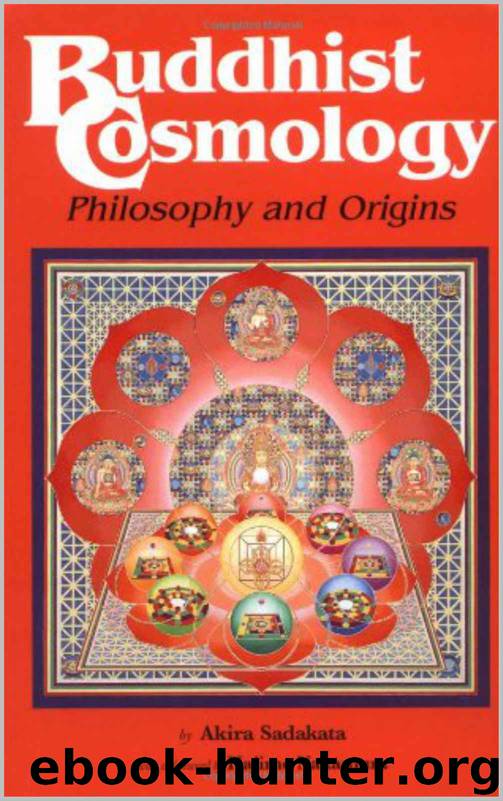Buddhist Cosmology: Philosophy and Origins by Akira Sadakata

Author:Akira Sadakata [Sadakata, Akira]
Language: eng
Format: azw3
Publisher: UNKNOWN
Published: 2018-05-02T04:00:00+00:00
7. The Buddha and the Cosmos As we have seen, pre-Mahayana Buddhism makes a distinction between the realm where the Buddha dwells and the realm of delusion. Although Mahayana Buddhism also posits the existence ofbuddha-realms and our own defiled world, another key element of Mahayana cosmology is the premise that the Buddha is omnipresent in our own realm. As this idea developed, the Buddha came to be equated with the world. The origin of this view is an attempt to interpret the nature of a buddha by positing the existence of various buddha bodies.
For followers of pre-Mahayana Buddhism, the Buddha was a historical figure; he had already entered nirval).a (eternal peace), so he did not now inhabit this world. The stupa was none other than a grave, a construction symbolizing the Buddha's death. 1 As time and distance between the Buddha and his followers increased during the centuries following his death, believers tended to deify the Buddha. The Lotus Siitra (1st century C.E.), which speaks of an eternal Buddha of whom the historical Buddha is no more than a single manifestation, and above all the Flower
Garland Siitra (Avataqlsaka-sutra, ca. 3d~4th century C.E.), express the idea that numerous buddhas exist simultaneously in the universe. This is a fundamental principle of Mahayana Buddhism.
In a relief called "Miracle at Sravasti" (photo 5), Sakyamuni manifests himself as a multitude of buddhas in order to gain acceptance among followers of non-Buddhist sects. The miracle at
143 Sravasti is a pre-Mahayana theme, but the relief can also certainly be interpreted in terms of the Flower Garland Siitra. It may even have been created to express that sutra's teachings that the Buddha is present everywhere in the universe (note the lotus throne on which the Buddha sits, a Mahayana element). The Heavenly Stories (Divyavadana, 3d-4th century C.E.) describes the miracle at Sravasti as buddhiivatar(lsaka ("adornment, or glorious manifestation, of the Buddha"). This expression is identical to that used in the full title of the Flower Garland Siitra, Mahavaipulyabuddhavatarpsaka-sutra. It means that countless buddhas manifest themselves in this realm, thereby adorning it. To understand this idea more fully, we must first explore the cosmology of the Lotus Repository World, which graphically pictures the Buddha's multiplicity and all-pervading presence.
It is important to keep in mind that the concepts of the Lotus Repository World and the pure lands have different origins. Furthermore, the pure lands are located outside Saha (our world), while the Lotus Repository World embraces all worlds, including the trichiliocosm, the largest conception of space in preMahayana Buddhism.
THE LOTUS REPOSITORY WORLD It is interesting that the Chinese translated avatar(lSaka in the Flower Garland Siitra's title as hua-yen, literally, "flower adornment." Though the wordjlower (or lotus) does not appear in the Sanskrit title, it was incorporated into the Chinese because the sutra describes the universe as a lotus flower. The chapter of the sutra titled "Lotus Repository World" describes the universe in the following way. 2
The universe contains layers upon layers of wind circles, as portrayed in figure 25, equivalent in number to the particles of sand there would be if Mount Sumeru were ground into dust.
Download
This site does not store any files on its server. We only index and link to content provided by other sites. Please contact the content providers to delete copyright contents if any and email us, we'll remove relevant links or contents immediately.
The Way of Zen by Alan W. Watts(6289)
Ego Is the Enemy by Ryan Holiday(4959)
The Art of Happiness by The Dalai Lama(3848)
The Book of Joy by Dalai Lama(3699)
Why Buddhism is True by Robert Wright(3284)
Spark Joy by Marie Kondo(3088)
Shift into Freedom by Loch Kelly(3029)
Happiness by Matthieu Ricard(2884)
A Monk's Guide to a Clean House and Mind by Shoukei Matsumoto(2784)
The Lost Art of Good Conversation by Sakyong Mipham(2439)
The Meaning of the Library by unknow(2385)
The Third Eye by T. Lobsang Rampa(2172)
The Unfettered Mind: Writings from a Zen Master to a Master Swordsman by Takuan Soho(2158)
Red Shambhala by Andrei Znamenski(2071)
Anthology by T J(2046)
The Diamond Cutter by Geshe Michael Roach(1955)
Thoughts Without A Thinker: Psychotherapy from a Buddhist Perspective by Epstein Mark(1896)
Advice Not Given by Mark Epstein(1764)
Twilight of Idols and Anti-Christ by Friedrich Nietzsche(1762)
